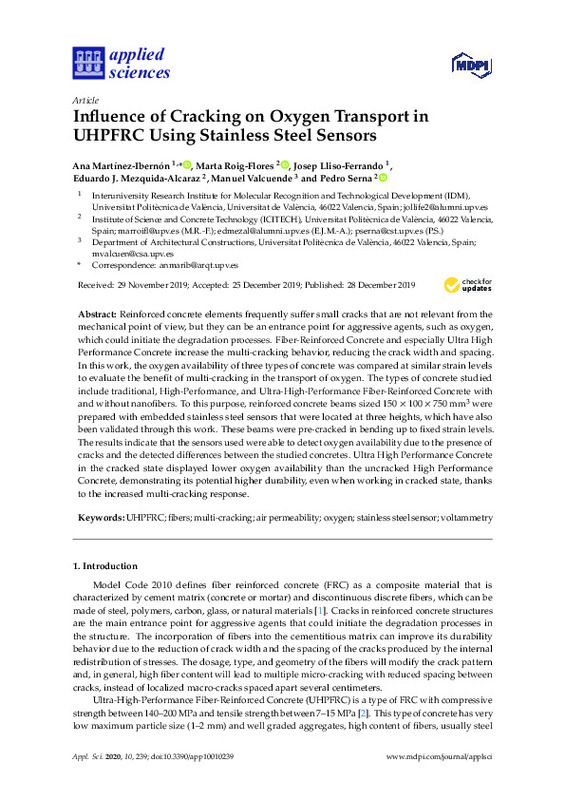Front Matter. (2013). fib Model Code for Concrete Structures 2010, I-XXXIII. doi:10.1002/9783433604090.fmatter
Yoo, D.-Y., & Banthia, N. (2016). Mechanical properties of ultra-high-performance fiber-reinforced concrete: A review. Cement and Concrete Composites, 73, 267-280. doi:10.1016/j.cemconcomp.2016.08.001
Wittmann, F., & Van Zijl, G. (Eds.). (2011). Durability of Strain-Hardening Fibre-Reinforced Cement-Based Composites (SHCC). doi:10.1007/978-94-007-0338-4
[+]
Front Matter. (2013). fib Model Code for Concrete Structures 2010, I-XXXIII. doi:10.1002/9783433604090.fmatter
Yoo, D.-Y., & Banthia, N. (2016). Mechanical properties of ultra-high-performance fiber-reinforced concrete: A review. Cement and Concrete Composites, 73, 267-280. doi:10.1016/j.cemconcomp.2016.08.001
Wittmann, F., & Van Zijl, G. (Eds.). (2011). Durability of Strain-Hardening Fibre-Reinforced Cement-Based Composites (SHCC). doi:10.1007/978-94-007-0338-4
Li, V. C. (2003). On Engineered Cementitious Composites (ECC). Journal of Advanced Concrete Technology, 1(3), 215-230. doi:10.3151/jact.1.215
Asgari, M. A., Mastali, M., Dalvand, A., & Abdollahnejad, Z. (2017). Development of deflection hardening cementitious composites using glass fibres for flexural repairing/strengthening concrete beams: experimental and numerical studies. European Journal of Environmental and Civil Engineering, 23(8), 916-944. doi:10.1080/19648189.2017.1327888
Ravindrarajah, R. S., & Swamy, R. N. (1989). Load effects on fracture of concrete. Materials and Structures, 22(1), 15-22. doi:10.1007/bf02472690
Bascoul, A. (1996). State of the art report—Part 2: Mechanical micro-cracking of concrete. Materials and Structures, 29(2), 67-78. doi:10.1007/bf02486196
Damgaard Jensen, A., & Chatterji, S. (1996). State of the art report on micro-cracking and lifetime of concrete—Part 1. Materials and Structures, 29(1), 3-8. doi:10.1007/bf02486001
Berrocal, C. G., Löfgren, I., Lundgren, K., Görander, N., & Halldén, C. (2016). Characterisation of bending cracks in R/FRC using image analysis. Cement and Concrete Research, 90, 104-116. doi:10.1016/j.cemconres.2016.09.016
Correia, M. J., Pereira, E. V., Salta, M. M., & Fonseca, I. T. E. (2006). Sensor for oxygen evaluation in concrete. Cement and Concrete Composites, 28(3), 226-232. doi:10.1016/j.cemconcomp.2006.01.006
Yoon, I.-S. (2018). Comprehensive Approach to Calculate Oxygen Diffusivity of Cementitious Materials Considering Carbonation. International Journal of Concrete Structures and Materials, 12(1). doi:10.1186/s40069-018-0242-y
Banthia, N., Zanotti, C., & Sappakittipakorn, M. (2014). Sustainable fiber reinforced concrete for repair applications. Construction and Building Materials, 67, 405-412. doi:10.1016/j.conbuildmat.2013.12.073
Berrocal, C. G., Löfgren, I., & Lundgren, K. (2018). The effect of fibres on steel bar corrosion and flexural behaviour of corroded RC beams. Engineering Structures, 163, 409-425. doi:10.1016/j.engstruct.2018.02.068
Sisomphon, K., Copuroglu, O., & Koenders, E. A. B. (2012). Self-healing of surface cracks in mortars with expansive additive and crystalline additive. Cement and Concrete Composites, 34(4), 566-574. doi:10.1016/j.cemconcomp.2012.01.005
Ferrara, L., Krelani, V., & Carsana, M. (2014). A «fracture testing» based approach to assess crack healing of concrete with and without crystalline admixtures. Construction and Building Materials, 68, 535-551. doi:10.1016/j.conbuildmat.2014.07.008
Roig-Flores, M., Pirritano, F., Serna, P., & Ferrara, L. (2016). Effect of crystalline admixtures on the self-healing capability of early-age concrete studied by means of permeability and crack closing tests. Construction and Building Materials, 114, 447-457. doi:10.1016/j.conbuildmat.2016.03.196
López, J. Á., Serna, P., Navarro-Gregori, J., & Camacho, E. (2014). An inverse analysis method based on deflection to curvature transformation to determine the tensile properties of UHPFRC. Materials and Structures, 48(11), 3703-3718. doi:10.1617/s11527-014-0434-0
Lopez, J. A., Serna, P., Camacho, E., Coll, H., & Navarro-Gregori, J. (2014). First Ultra-High-Performance Fibre-Reinforced Concrete Footbridge in Spain: Design and Construction. Structural Engineering International, 24(1), 101-104. doi:10.2749/101686614x13830788505793
Negrini, A., Roig-Flores, M., Mezquida-Alcaraz, E. J., Ferrara, L., & Serna, P. (2019). Effect of crack pattern on the self-healing capability in traditional, HPC and UHPFRC concretes measured by water and chloride permeability. MATEC Web of Conferences, 289, 01006. doi:10.1051/matecconf/201928901006
[-]









